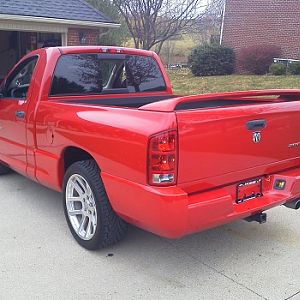Caveman:
Yes, altitude plays a huge part in performance, as you are keenly aware.
A couple of brand new QC SRT-10s around here were running 15.3s; Same truck could run 14.6-14.7s at sea-level on an average day.
Far more accurate than e.t. for power comparisons though is comparing m.p.h. and they would pick up 8 or 9 m.p.h. at sea-level.
We beta-tested the first E-Force Supercharger kit installation in Canada for Edelbrock on an SS Camaro (Jason Fairley's shop) and it was down on power 10% across the board compared to sea-level numbers.
It picked up and was bang-on where it was supposed to be once it was able to run at sea-level (with zero changes). I.O.W. it gained 10% more power at the lower altitude.
Throw in anemic weather fluctuations and our 3800 foot mean altitude changes to 7800 feet (or worse). NOW, the low power really becomes evident!!
You likely experience the same thing in your area..
Some guys say they can notice the pressure drop on a compression test at the higher altitudes. This stands to reason, but I've found it inconclusive with a standard graduated compression tester.
Anyway, 10 p.s.i. supercharger kits will develop 7- 7.5 p.s.i. here in Calgary but will provide their advertised 10 psi gain at sea-level.
And you can typically expect 2.75-3.0 p.s.i. out of a stock Roe-style supercharger kit at our altitude (same I'm sure, where you are).
So, in other words, racing at a sea-level track compared to here is like bolting on a 3 p.s.i. supercharger; it's the same I'm sure where you are.
F.I. engines don't seem to be impacted as much as the N.A. vehicles, but even top-fuelers (or anything else) won't break records on high altitude tracks where you or I live.
I haven't really kept track of the diesels' performance changes due to altitude but unless they are ingesting large volumes of air (modified head), they likely suffer less at high altitudes than a gas engine.
It can get expensive to get something to go fast reliably.
Racing at sea-level is a cheap way to get big gains!
And yes, technology is allowing BIG power from the diesels these days.
The tranny business is booming: "Gee, why can't I pull my 30 foot trailer up a mountain at w.o.t. with my double-chipped diesel"??

But $14,000 for ONE Diesel head?!?
And some guys thought Strikers were expensive.

Hey, maybe I'll design my own cylinder head for the Cummins and call them STOKERS.






